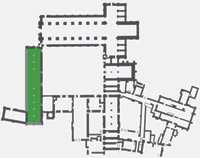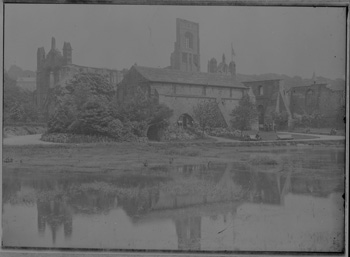|
|
You are here:
 The western or lay-brother's range
The western or lay-brother's range
 (1/2) (1/2) |
The western range at Kirkstall, as at other Cistercian
houses, was primarily used by lay-brothers
who worked and lived at the abbey rather than on the granges. Here
they had their own refectory, dormitory and toilet-block (reredorters);
it is likely that a timber infirmary for their use was situated
nearby. The northern part of the range was used as a cellar and
also had an outer parlour which functioned as a meeting place -
merchants might conduct business here, the monks might speak with
family and friends. In Benedictine house, where there were no lay-brothers,
the western range was occupied by the cellarer and generally also
had accommodation for guests.
The western range at Kirkstall was vaulted and
measured c. 50 m x 8 m. The building survived – complete with
its roof – until 1746 when the southern and western walls collapsed.
The range was divided into eleven bays, the northernmost of which
was used as the outer parlour. The cellar occupied the next four
bays (bays 2-5), and it was here that grain, salted fish and other
provisions for the community were stored, as well as hides and wool
that were to be taken to market or sold to merchants. The entrance
to the cloister was in the sixth bay, and remains of the inner doorway,
which is blocked up, are visible. The lay-brothers’ refectory
occupied the ground floor of the remaining five bays (bays 7-11),
and was entered through a wide door in the ninth bay. The tables
would have been arranged around the walls and, like the monks, the
lay-brothers would have sat facing inwards. There was no reading
during the lay-brothers’ meals and consequently there was no
pulpitum in their refectory. Nevertheless, the lay-brothers
were to remain silent while eating and observe good table manners.
The lay-brothers’ ate the same food as the monks but generally
received larger portions on account of their heavy labour. They
were also served a light breakfast, the mixt, which was taken
by novices, servers and
the infirm. Their food was prepared in the same kitchen as the monks’
and was passed to the refectory through a serving hatch in the eighth
bay. The lay-brothers at Kirkstall may also have gathered in the
refectory for their weekly chapter meeting.
<back><next>
|







 (1/2)
(1/2)